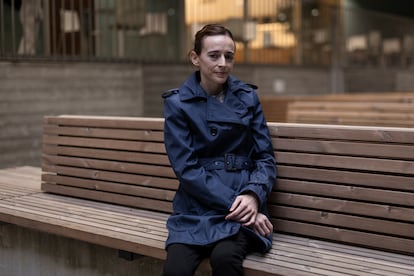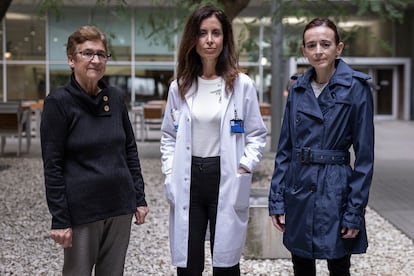Electrodes in the brain to fight Belén’s severe anorexia: ‘I found joy again’
The Hospital del Mar in Barcelona, Spain, is practicing an experimental neuromodulation technique to reduce symptoms of anxiety and obsession in the most stubborn cases

Four yogurts and two apples a day. Nothing else. That was all Ana Belén Gómez Conde ate for 15 years. Anorexia entered her life shortly after she got married, when she was 27 years old (she is now 42) and never left. She stopped eating, going out, and interacting with the world. Locked in her house in Monterroso (Spain), Belén was simultaneously dealing with this devastating disease and a lack of understanding from almost everyone around her: “No one understood me. Only my mother, only she knew how to understand that if I didn’t eat it was not because I didn’t want to, but because I had an illness,” she recalls.
Anorexia silently devoured her until she could not stand up. She asked to die to end the suffering, but she also wanted to live. So much so that she grasped the last straw, which she found on the other side of the country. An experimental treatment with deep brain stimulation to treat the most serious anorexia nervosa was being tested at the Hospital del Mar in Barcelona.
The first time she saw Belén is seared into neurosurgeon Dr. Gloria Villalba’s memory. “Her mother was leading her by the hand because she couldn’t walk. And she told me: ‘This is my daughter. She is dying,’” the doctor recalls emotionally. In front of her, Belén and her mother, Mari Carmen Conde, 66, nod silently. Words are not enough to explain those days when the disease took everything away. “It was very hard. I saw that she was leaving this world,” Belén’s mother manages to say. Villalba goes into more detail about the ordeal: “When her daughter went to sleep, Mari Carmen watched to see if she was breathing so that she would not die of cardiac arrest. This mother went years without sleep to monitor her daughter’s breathing as if she were a baby.”
Belén was on the verge of death and the experimental procedure at the Hospital del Mar was her last chance. The therapy was not going to work miracles or cure anorexia, Villalba warned her in the first meeting. But if it worked, it could help alleviate some of the symptoms, such as anxiety and depression, that often accompany anorexia. The same hospital had conducted a study with a group of eight patients, and showed that symptoms improved in four of them after being treated with deep brain stimulation.
This technique, which is already being used to treat Parkinson’s and obsessive-compulsive disorder, is being tested in other psychiatric illnesses. It consists of implanting electrodes in a part of the brain associated with the disease (in this case, the subgeniculate cingulum), and sending continuous electrical impulses to modulate the activity of circuits in the brain that are not working well. The stimulation is adjustable and reversible because the electrodes are attached, via cable, to a battery under the skin that can turn the electrical impulse on or off, or modulate its intensity.
“We don’t know which part of the brain causes anorexia. It is thought to be a circuit more than an area. In our clinical trial we tested two areas of the brain [the nucleus accumbens and the subgeniculate cingulum] and the subgeniculate cingulum worked better for us,” explains Villalba. In practice, she says, it is a neuromodulation, “because there are several parts in a circuit, and some activate it and others inhibit it.”
In the case of Belén, the subgeniculate cingulum was underperforming and had to be stimulated, but, at the same time, other areas that were taking on this function also needed to be inhibited. Villalba explains that “in neurological diseases, instead of all parts of the circuit being proportional, there is one part that stops working and another that takes center stage. And that leads to bad things.”
The intervention is “an elegant surgery,” says Villalba. The entire skull does not have to be opened, but the brain is accessed through two small holes and the electrodes are fitted with a robotic arm. The operation, however, is not without its dangers. That is why patients must be very carefully chosen, and the risks and benefits must be measured. “There is a 1% risk of hemorrhage, a 5% risk of infection, and a 3% risk of decubitus [erosion of the tissue where the implant is located]. But the probability that a patient with anorexia nervosa will die is 30%. Although the operation has risks, the disease itself outweighs them,” the neurosurgeon adds, putting the risks into context.
Does not cure, but improves symptoms
The neurosurgeon reiterates, however, that this procedure “does not treat the disease, but rather some of its symptoms.” It minimizes obsession, depression, and anxiety, she insists. “After fitting the electrodes, the patient continues to think as they did before. Belén still thinks about calories. What has changed is that she is less anxious, less depressed and this has allowed her to do things that were previously unthinkable due to her depression and anxiety. She is more tolerant and that creates more peace of mind, she is eating a little more, and she is more cheerful,” the doctor, who has written her doctoral thesis on this technique in anorexia, explains. It is not, in any case, a procedure available to anyone with anorexia. The technique is still in the experimental phase and is reserved for people whose situation is very serious. These patients have lived with a disease that has developed over many years. It is resistant to all treatments and there are no therapeutic alternatives.
It was not easy for Belén to get to the Hospital del Mar. Being from another region of Spain, the health department of that region (Galicia) rejected her referral for surgery that involved an experimental treatment and a patient in such a deteriorated state. So, she and her mother settled in Barcelona. They paid for the trip out of their own pockets. Belén got registered with the city’s health authority, rented a small apartment near the hospital, and she and her mother have been there for more than a year.
She had surgery in January 2023 and the procedure worked. “I found joy again. Within weeks, I no longer had depression, migraines, or anxiety. I could laugh again, I enjoyed myself, I wanted to walk, have a good time, and go shopping. It was a radical change,” says Belén. She is better, but she is not cured. As Villalba warned her from the first consultation, the anorexia is still there, but she has already taken giant steps forward. “I can try everything, but eating things that have sugar or oil, well no,” she says, and confesses that she is less tired: “Before I couldn’t stand up and now I am able to walk a good distance.” According to the nutritionists who are monitoring her development, she has gone from taking in just 250 kilocalories a day to 1,800.

The patient has even improved, despite the setback she suffered in June, when the battery became infected and had to be removed for a few weeks. At that time, she noticed the blackout in the neuromodulation, but last September surgeons put the device back in, and she came back. “Belén is an example of the success that this procedure can have in some patients. But I insist, this is not for everyone,” Villalba reiterates again and again. For now, it is reserved for chronic and very serious cases. “Our help is for those who are going to die. Perhaps, the day we know more, we will recommend it to more people. But this procedure, specifically, must be done with someone whose life is really in danger,” the doctor explains.
Knowledge is still limited. There are only 78 people with anorexia undergoing this surgery worldwide, Villalba points out, and the results are variable. “Today, we do not know what the best target is (three have been tested), nor what the ideal patient profile is. We are still in the early stages,” she admits.
Where the most patients have been treated is in China and they have gotten positive results, but they tend to be more lax in choosing patients, the doctor explains. “They go directly to surgery, without the disease being chronic. They are giving surgery to 17-year-olds. But we will always have the doubt as to whether they would have improved anyway due to the natural evolution of the disease itself.”
A group in Oxford has reported seven cases, but with more unfavorable results. In their research, they chose to focus on the nucleus accubens, an area of the brain that did not give good results to Villalba’s team either. “The one who has done very well is the Canadian group, who have published their results from treating 18 patients. As a criticism, they have accepted serious patients, but they agreed to come in and gain about 26 pounds before the surgery, and that is already a wonderful profile,” points out the neurosurgeon.
A little explored path
Since it is an experimental technique, scientists do not know much about the long term either. “There is not enough experience in the world to know what is going to happen. We don’t know if they are going to continue well, or if patients will have to increase the intensity of the treatment. Belén will have to have tests to check the system,” says Villalba.
In movement disorders, such as Parkinson’s disease, there is more experience with this technique: “We have been using it for 30 years and now it is used routinely in a profile of patients who do not respond to other drugs. It is an effective implant. What you do is modulate the activity of the neurons and you improve the symptoms,” explains Álvaro Sánchez Ferro, coordinator of the Movement Disorders Study Group at the Spanish Society of Neurology. It has also been tested in epilepsy and dementia, but with irregular results, the neurologist adds. Each pathology is its own world.
The scientific community is also investigating the potential of this technique in other mental disorders. The Hospital Clínic of Barcelona has tested deep brain stimulation in schizophrenia and bipolar disorder. “With neuromodulation techniques we try to respond to patients who are resistant to drugs and psychotherapy. Pathologies where the brain circuitry is well known and where we know that, by inhibiting a brain nucleus, we can regulate a pathway, are the ones that have a good profile. In more diffuse mental disorders, such as autism, it may not have as much of an effect,” explains Miquel Bioque, a psychiatrist at the Clínic who is leading this research.
The doctor, who admits that he is no a specialist in the field of anorexia, does emphasize, however, that in his experience with bipolar disorder and schizophrenia, improvements have been seen and the patient is able to celebrate them. But he points to an eventual complexity in anorexia: “In this case, the improvement is gaining weight and a patient with anorexia does not want that. That’s why I see it as more complex for the improvements to be consolidated.”
Villalba herself admits in her thesis that, when recruiting patients with severe anorexia “it is difficult for these patients to accept a treatment that can make them gain weight.” In any case, patients treated in the field of psychosurgery are few and far between, and the evidence is limited, Bioque admits. “These are complex interventions, they are not done in any old hospital, they are expensive and it is not so easy to find suitable patients. For now, it is important to clearly define the clinical profiles to see where the patient improves and which patients are the most suitable.”
Sign up for our weekly newsletter to get more English-language news coverage from EL PAÍS USA Edition
Tu suscripción se está usando en otro dispositivo
¿Quieres añadir otro usuario a tu suscripción?
Si continúas leyendo en este dispositivo, no se podrá leer en el otro.
FlechaTu suscripción se está usando en otro dispositivo y solo puedes acceder a EL PAÍS desde un dispositivo a la vez.
Si quieres compartir tu cuenta, cambia tu suscripción a la modalidad Premium, así podrás añadir otro usuario. Cada uno accederá con su propia cuenta de email, lo que os permitirá personalizar vuestra experiencia en EL PAÍS.
¿Tienes una suscripción de empresa? Accede aquí para contratar más cuentas.
En el caso de no saber quién está usando tu cuenta, te recomendamos cambiar tu contraseña aquí.
Si decides continuar compartiendo tu cuenta, este mensaje se mostrará en tu dispositivo y en el de la otra persona que está usando tu cuenta de forma indefinida, afectando a tu experiencia de lectura. Puedes consultar aquí los términos y condiciones de la suscripción digital.
More information
Archived In
Últimas noticias
Most viewed
- Reinhard Genzel, Nobel laureate in physics: ‘One-minute videos will never give you the truth’
- Oona Chaplin: ‘I told James Cameron that I was living in a treehouse and starting a permaculture project with a friend’
- Pablo Escobar’s hippos: A serious environmental problem, 40 years on
- Why we lost the habit of sleeping in two segments and how that changed our sense of time
- Charles Dubouloz, mountaineering star, retires at 36 with a farewell tour inspired by Walter Bonatti











































